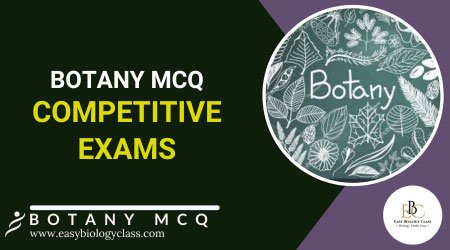Preparing for competitive exams that feature Botany can be challenging due to the vast scope of the subject. Mastering multiple-choice questions (MCQs) in Botany requires not only a strong understanding of plant science fundamentals but also familiarity with diverse subtopics like plant physiology, taxonomy, and genetics. These questions test both conceptual clarity and the ability to recall intricate details. Practicing Botany MCQs enhances analytical thinking and helps in identifying knowledge gaps. This article on Botany MCQ for Competitive Exams will help you to prepare all competitive exams in biology. You can download this MCQ questions as PDF, the link is given below the post.
Botany Notes | Botany PPTs | Botany MCQs
(1). Which of the following structures is unique to plant cells?
(a). Mitochondria
(b). Cell wall
(c). Ribosomes
(d). Nucleus
Answer: (b). Cell wall: The cell wall is a rigid structure outside the cell membrane, unique to plant cells and some algae.
(2). What is the main function of the xylem in vascular plants?
(a). Transport of nutrients
(b). Transport of water
(c). Food storage
(d). Photosynthesis
Answer: (b). Transport of water: Xylem is responsible for the transport of water and minerals from roots to other parts of the plant.
(3). Which of the following best describes a sporophyte in the life cycle of plants?
(a). A haploid generation
(b). A diploid generation
(c). A stage that produces gametes
(d). A stage that undergoes meiosis
Answer: (b). A diploid generation: The sporophyte is the diploid, spore-producing phase of the plant life cycle.
(4). Which enzyme is involved in the initial fixation of carbon dioxide in C3 plants?
(a). PEP carboxylase
(b). Rubisco
(c). ATP synthase
(d). NADP reductase
Answer: (b). Rubisco: Rubisco catalyzes the first step of carbon fixation in the Calvin cycle of C3 plants.
(5). What type of tissue is responsible for the storage of starch in plants?
(a). Collenchyma
(b). Sclerenchyma
(c). Parenchyma
(d). Meristem
Answer: (c). Parenchyma: Parenchyma cells often store starch and other substances in plants.
(6). Which of the following statements about gymnosperms is true?
(a). They have enclosed seeds.
(b). They do not produce flowers.
(c). They are primarily aquatic plants.
(d). They lack vascular tissue.
Answer: (b). They do not produce flowers: Gymnosperms reproduce without flowers and have exposed seeds.
(7). What is the primary role of phloem in plants?
(a). Gas exchange
(b). Transport of water
(c). Transport of sugars
(d). Absorption of minerals
Answer: (c). Transport of sugars: Phloem is responsible for transporting sugars and other metabolic products throughout the plant.
(8). The cuticle covering the epidermis of leaves primarily functions to:
(a). Aid in gas exchange
(b). Facilitate water absorption
(c). Prevent water loss
(d). Enhance photosynthesis
Answer: (c). Prevent water loss: The cuticle is a waxy layer that helps reduce water loss from the leaf surface.
(9). In angiosperms, the process of double fertilization results in:
(a). A zygote and a diploid endosperm
(b). Two zygotes
(c). A zygote and a triploid endosperm
(d). Two triploid endosperms
Answer: (c). A zygote and a triploid endosperm: Double fertilization leads to the formation of a diploid zygote and a triploid endosperm.
(10). What is the primary function of stomata?
(a). Water transport
(b). Nutrient absorption
(c). Gas exchange
(d). Mechanical support
Answer: (c). Gas exchange: Stomata are pores on the leaf surface that regulate gas exchange and water vapor release.
(11). Which pigment is directly involved in photosynthesis?
(a). Xanthophyll
(b). Chlorophyll a
(c). Carotene
(d). Anthocyanin
Answer: (b). Chlorophyll a: Chlorophyll a is the primary pigment that captures light energy for photosynthesis.
(12). Which of the following is NOT a type of ground tissue in plants?
(a). Parenchyma
(b). Collenchyma
(c). Sclerenchyma
(d). Xylem
Answer: (d). Xylem: Xylem is a vascular tissue, not ground tissue.
(13). The Casparian strip is found in:
(a). The epidermis of roots
(b). The endodermis of roots
(c). The mesophyll of leaves
(d). The cambium of stems
Answer: (b). The endodermis of roots: The Casparian strip is a barrier in the endodermis that regulates water and nutrient uptake.
(14). Which hormone is primarily responsible for promoting seed dormancy?
(a). Gibberellin
(b). Auxin
(c). Abscisic acid
(d). Ethylene
Answer: (c). Abscisic acid: Abscisic acid helps maintain seed dormancy and prevents premature germination.
(15). Which process converts atmospheric nitrogen into a form usable by plants?
(a). Denitrification
(b). Nitrogen fixation
(c). Ammonification
(d). Nitrification
Answer: (b). Nitrogen fixation: Nitrogen fixation converts atmospheric nitrogen into ammonia, a form usable by plants.
I hope you found this article on Botany MCQ for Competitive Exams is informative and beneficial. Your feedback and comments would be greatly appreciated. Whether you have suggestions, questions, or thoughts to share, I would be delighted to hear from you. Engaging with your comments helps me continue to produce high-quality content in Biology. Please feel free to leave a comment below. Thank you for your support.
Regards: Admin, EasyBiologyClass
Want to read offline? download full PDF here

